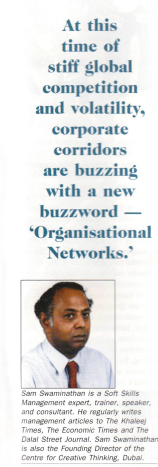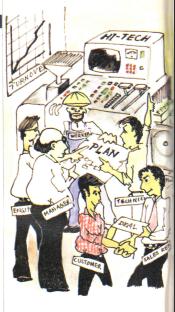Stop talking and start working’, has been an old adage for over a century splashed all over company corridors, cafeterias, and water fountains. The idea behind it was ostensibly to eliminate wastage of time. It was perfected by Henry Ford, and zealously practised by legions of managers around the world. Yet, at a time when Force 10 gales of increasing global competition and unrelenting change are buffeting businesses by the hour, company after company continues to follow this old paradigm. Nothing can be more outdated than this approach in today’s (and tomorrow’s even more uncertain) climate.
Just think back to the way in which information and knowledge have stood everything on its head. Fifty, or even twenty years ago, management hoarded information – and thus power. This worked at that time. The exact opposite is true today. Enlightened companies are working at a furious pace to capture knowledge with the help of networked computers so that knowledge, having entered the portals of a company, is captured, labelled, catalogued, and made available to whoever wants it. And by that I don’t mean only employees. It includes suppliers and customers as well.

Wait a minute, what do I mean by suppliers? Listen to this little story. In one of its truck plants, Ford had implemented a system which went somewhat like this; “Dear supplier, we like your brakes, and will continue to install them on our trucks, but until we do, they are your brakes, not ours. The brakes only become ours when we use them, and that’s when we’ll pay for them. Every time a truck comes off the line with a set of your brakes on it, we’ll mail you a check.”
To make this system work, the supplier had full access to Ford’s computerized manufacturing schedule, which allowed the supplier to schedule its own production and reduce the size of its inventory. A WIN-WIN situation, eh! The new paradigm is ‘Start talking (even with suppliers) and start working”!!
What about functions and divisions within a corporation talking to one another? What did Kodak do in 1987, when Fuji announced a new 35 mm single-use camera, the type that the customer buys with loaded film, uses once, and then returns to the manufacturer, for processing the film and tearing the camera part by part for reuse?
At that point, Kodak didn’t have a competitive offering even on the drawing board. Traditional product development and design methods would have taken Kodak at least seventy weeks to bring out a rival offering. Using CAD/CAM methods, Kodak invented a new process called Concurrent Engineering, where people from design, manufacturing, and marketing worked together. Each day a database system collected each engineer’s work and combined all the individual efforts into a coherent whole. Every morning found de sign groups and individuals inspecting the database to see whether someone else’s work from yesterday had created a problem. If there were any, they were resolved immediately, not weeks or months later. Result the seventy-week development time was cut to thirty-eight. As if that weren’t enough, Kodak reduced its tooling and manufacturing costs for the single-use camera by 25 percent!
So what does this lesson teach us? A new paradigm-Start talking (even with other divisions) and start working’. This requires Organizational Networks. Network means just what it says informal relationships and ties among people-ties that cut across the barriers of bureaucracy, new and innovative ways to share information using contemporary tools such as information technology and communication channels.
Networks don’t just happen. Management has to work assiduously to create them, and then allow them to operate free and unfettered. After all, networks are more positively productive than reorganization, reengineering, downsizing, etc.
CEOs should be responsible for clearly specifying why they are creating networks. Having done that, they should assemble members from across the company’s functions, and most importantly, from different levels of hierarchy. If you fill up the team with Divisional Managers, you can kiss good-bye to what you want to achieve. Go for the best and the brightest, never mind what positions they occupy. (Who knows, this may even shock you into realizing that the best are being smothered at the bottom of the barrel). Look for qualities such as knowledge, skill, judgement, personal motivation, drive, irreverence, daring, straight-speak. Only such a recipe can shape and deliver the corporate strategy in the real sense.
Next step – even more important the networks must be designed to empower people to talk freely, openly, candidly, and emotionally. Fear, thou shall not exist here’, should be the network’s slogan. Trust is the other ingredient mega doses of trust within the network. ‘What is right for our people and what is right for our customers is right for our corporation’ has got to be the motto of the group.

In May 1990, under Chairman Allan Taylor, such a network within the Royal Bank of Canada (RBC), Montreal, came up with as many as seventeen powerful proposals for change, arising from a close-knit group that routinely shared best practices, learned from each other’s problems, and worked together to understand the business more clearly. And yes, these seventeen people were not senior executives; they were middle level executives the real knowledge workers of the organization, the unsung heroes until then. How many CEOs would be prepared to help their troops understand the business clearly?
Want to know some of the network’s proposals at RBC? Here they are:-
1. Limit the number of branches under the control of an Area Manager to between 7 and 12.
2. Create formal mechanisms to allow Area Managers to share expertise and competitor intelligence systematically.
3. Guarantee 15 days (not 15 hours) of training per year for existing Area Managers and launch Area Manager University, an intensive series of courses and training modules. Provide resources so that all new Area Managers would be graduates of the university by the spring of 1991.
4. Institute standard minimum autonomies for all Area Managers, including the right to hire, transfer, and evaluate employees below a certain pay grade, and the right to freely substitute between certain expense categories within the overall budget constraints. Negotiate even greater autonomies with high-performing Area Managers. Boy, have you seen a better list of concrete deliverables from any committee or group? Even more baffling, by November 1991, these had been achieved.
Don’t you think it’s high time CEOs of banks and other organizations did something other than just rock the boat stuff? Customers and staff are tired of empty slogans, and it will soon begin to tell. How long can you continue this way?


